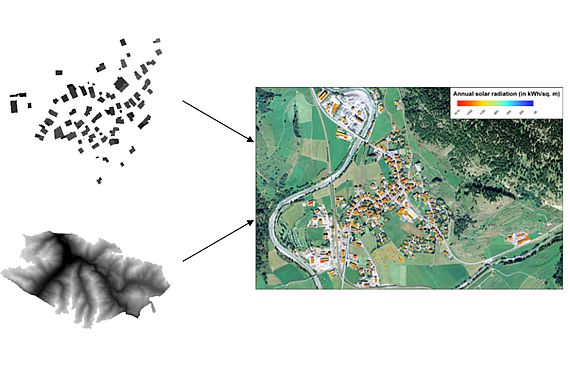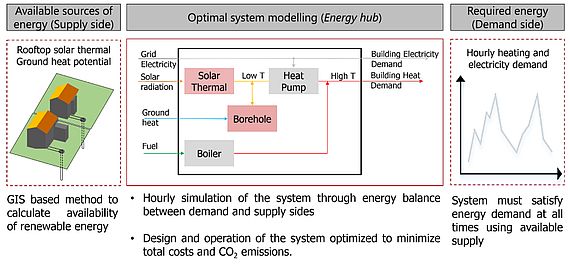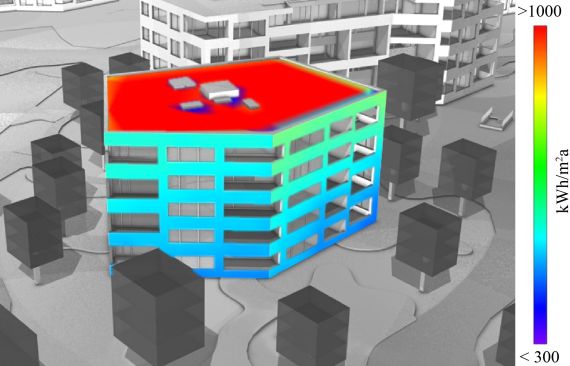Renewable potential assessment
Building integrated and urban energy supply potentials are required for the useful investigation the energy supply side of urban energy systems. These renewables include solar energy, wind energy, hydropower, bioenergy, environmental heat, etc. Methods for time-resolved evaluation of potentials are developed using GIS and other simulation techniques.

Geo-spatial aspects of urban energy systems
Solar thermal collectors and ground source heat pumps (GSHPs) are one of the most commonly used renewable energy technologies for delivering heat energy to buildings. These technologies can either be installed as standalone systems within individual buildings (decentralized) or locally at the district level using pipe networks. There exists a tradeoff between decentralized and centralized installation of these systems in terms of total costs and carbon dioxide emission savings, which is affected by the spatial and temporal availability of solar irradiation and ground heat. Furthermore, these technologies are suitable for delivering heat energy at relatively low temperature which necessitates either the use of auxiliary heating technologies or demand side measures such as building retrofit.
This project in the framework of the SCCER FEEB&D intends to quantitatively evaluate the tradeoff between decentralized and centralized renewable energy based heating systems for residential buildings, focusing on their spatial and temporal potential.

Feasibility of façade PV
This study conducted a global variance-based sensitivity analysis of factors determining the feasibility of facade based photovoltaic (PV) for a residential multi-story building in Switzerland. Motivations for facade PV include limited roof areas (especially in the case of tall buildings), and a mismatch between electricity demand and solar energy production of South-oriented and rooftop PV - an effect known as the "duck-curve". We calculate high resolution solar potentials on the building facades, considering the shading of surrounding buildings and vegetation. The feasibility of facade PV is evaluated under different energy system scenarios and operational carbon emission targets. The sensitivity analysis shows high sensitivity of the feasibility of facade PV to available solar potentials and to electricity demand, demonstrating the importance of context and of appropriate solar modeling. Furthermore, our results show that in this residential case study facade PV is only lucrative in the presence of carbon constraints and if no storage technologies (batteries) are available. However, as soon as storages are introduced as possible technology, it is more cost-efficient to invest in batteries as opposed to facade PV.

Publications
Mavromatidis G, Orehounig K, Carmeliet J. (2015) Evaluation of photovoltaic integration potential in a village. Solar Energy – Special Issue Solar world congress 2015, Vol 121, 152-168. https://doi.org/10.1016/j.solener.2015.03.044
Mavromatidis G, Orehounig K, Carmeliet J. (2015) Evaluation of solar energy integration potential in a neighborhood. In: 14th International Conference of the International Building Performance Simulation Association (IBPSA), BS 2015, Hyderabad, India, December 7th – 9th 2015. https://www.dora.lib4ri.ch/empa/islandora/object/empa%3A9544/datastream/PDF/view
Miglani S, Orehounig K, Carmeliet J. (2015) A method for generating hourly solar radiation on building rooftops accounting for cloud cover variability. In: CISBAT 2015, Lausanne, Switzerland, September 9th – 11th 2015. https://infoscience.epfl.ch/record/213400/files/7_MIGLANI.pdf
Miglani, S., Orehounig, K., Carmeliet, J. (2018) 'A methodology to calculate long-term ground heat potential for an urban neighbourhood' Energy and Buildings Vol 159, 462-473. https://www.sciencedirect.com/science/article/pii/S0378778817317450?via%3Dihub
Orehounig K, Mavromatidis G, Derome D, Carmeliet J. (2015) Photovoltaic panels as a main component of energy sustainable communities: comparative energy analysis of a village under Swiss and South African climatic loads. In: Third Southern African Solar Energy Conference, SASEC 2015, Skukuza, Kruger National Park, South Africa, May 11th – 13th 2015. https://www.dora.lib4ri.ch/empa/islandora/object/empa%3A9546/datastream/PDF/view
Waibel, C., Mavromatidis, G., Bollinger, A., Evins, R., Carmeliet, J. (2018) Sensitivity analysis on optimal placement of façade based photovoltaics. In: Proceedings of 31st International Conference on Efficiency, Cost, Optimization, Simulation and Environmental Impact of Energy Systems (ECOS 2018), Guimarães, Portugal, June 17th – 21st 2018. https://www.researchgate.net/publication/325949414_Sensitivity_analysis_on_optimal_placement_of_facade_based_photovoltaics

